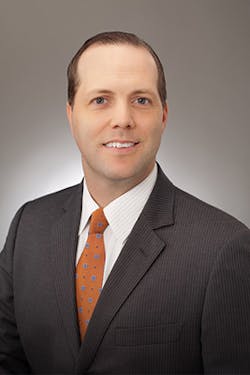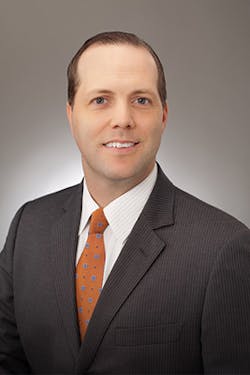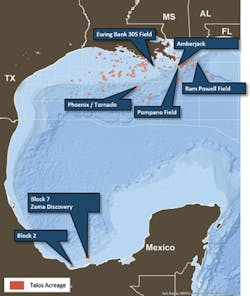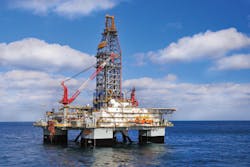Talos Energy CEO: Offshore Mexico offers significant long-term opportunity
Bruce Beaubouef
Managing Editor
Houston-based Talos Energy LLC has remained active over the past few years, even in the midst of one of the industry’s most prolonged downturns in recent memory.
Talos was one of the first American oil and gas companies to seize on the opportunity posed by Mexico’s oil and gas reforms launched in late 2013. Talos was then part of the consortium that made history offshore Mexico in July 2017 with the Zama-1 well discovery, which was the first offshore exploration well drilled by the private sector in Mexico’s history. And, the find is expected to be prolific: the Zama field’s oil in place is expected to be between 1.4 and 2.0 Bboe.
Later that same year, in November 2017, Talos acted upon the opportunity presented by the downturn to acquire Lafayette-based Stone Energy Corp., a move that would give Talos two core areas in the Gulf of Mexico: leases in the US deepwater Gulf and in the shallow-water Mexican Gulf. The combination is expected to give Talos the technical resources and balance sheet that can support its development plans while at the same time “giving us the horsepower to pursue compelling transactional and exploration opportunities,” says Tim Duncan, President and CEO of Talos Energy.
Duncan
Talos was formed in March 2012 and initially funded with a $600-million equity raise from Apollo Global Management, LLC and Riverstone Holdings LLC. As originally conceived, Talos Energy would be an independent oil and gas company focused on offshore exploration and production based along the Gulf Coast and in the US Gulf of Mexico. Since its inception in 2012, Talos has grown from five original employees to over 350 employees with over 150 MMboe of proved reserves and approximately 50 Mboe/d of net production.
Recently,Offshore met with Duncan to discuss his views on the opportunities posed by Mexico’s energy reforms, its merger with Stone Energy, and the state of the offshore oil and gas market in general.
•••
Offshore: Can you tell a bit about how Talos Energy was formed, how the management team came together, and how the company sees its mission or place in the offshore oil and gas marketplace?
Duncan: The three co-founders (myself, Steve Heitzman and John Parker) all worked together at previous private start-ups that we eventually sold, and we were fortunate to have success in both companies. We came together at Talos with the idea that it had to be bigger and that we might have to access the public markets. In that light, we also thought we might want to expand outside the US Gulf of Mexico into other offshore areas where we thought we could be competitive. Our goal was to create a leading offshore independent E&P company at a time when so many are competing for onshore plays, with the idea that we could be more competitive with less companies competing for reserves and prospects.
Talos key assets. (Courtesy Talos Energy)
Offshore: One of Talos Energy’s key corporate strategies has been to employ a regional seismic approach that reduces exploration and operating risks and optimizes drilling opportunities. Can you elaborate on how these strategies have enabled your company to revitalize older GoM shelf assets, and lower finding, drilling and development costs on deepwater assets and fields?
Duncan: We have always been relentless in not giving up on assets and continuing to see if we can do more in and around known hydrocarbon traps and existing infrastructure and fixed costs, so that every incremental barrel is accretive. The most impactful production we can run through acquired infrastructure is from new drilling and we want to continue to build out a drilling inventory, continually finding an edge geophysically, typically through our reprocessing efforts.
Offshore: What strategies has Talos Energy used to survive and navigate the downturn?
Duncan: We think there are a couple tenets to who we are that helped us navigate the downturn. First, we try to always be well hedged which insulates us for some period of time; then we work very hard on portfolio development with all levels of risk: in-field opportunities, exploration around our assets, and exploration abroad. When you are in a commodity crisis, you have to pull back on your capital program but hope you can still allocate capital into projects that will help you sustain the downturn. We focused on driving down expenses, then we focused on recompletions so that we could manage P&A spending on our shelf assets, and our drilling campaigns. Our Tornado II discovery in the US GoM was the result of this type of approach, and came right as we were also working to reduce our debt levels.
Offshore: Talos Energy has been able to get an early foothold in the opening up of the Mexican offshore oil and gas market. Can you talk more about the opportunity you see offshore Mexico?
Duncan: The opportunity was easy in our view because it is a huge, underdeveloped hydrocarbon province with geology we understand that responds to the geophysical techniques we like to deploy, so it made perfect sense to us.
Offshore: Was the offshore Mexico opportunity something that Talos Energy had been targeting even before the Mexican energy reform legislation of 2013? Or was it more the result of already having a presence in the US Gulf, and being able to react quickly to events?
Duncan: It is certainly the latter. Even though we were considering ideas outside our normal US GoM business opportunities, we never thought offshore Mexico would open up. It is such a prolific basin, and with only one operator, when it did open we immediately focused on it.
Offshore: In July 2017, Talos announced the Zama-1 exploration well discovery, which was notable for a couple of reasons. It was the first offshore exploration well drilled by the private sector in Mexico’s history, and initial gross oil in-place estimates range 1.4 to 2.0 Bbbl. Can you give us an update on the development work here?
Duncan: It starts with appraisal so we will drill several penetrations to define the limits of the discovery and narrow the recoverable range from what we have currently guided. It is in shallow water, so we know fixed structures will work, and the question is really whether we need more than one and how to appropriately place them, what production capacity will be needed, and so on. Our appraisal plan and subsequent FEED studies will help us get to FID quickly.
TheENSCO 8503 semisubmersible rig drilled the Zama-1 well for Talos Energy in block 7 of the Sureste basin offshore Mexico. (Courtesy Ensco)
Offshore: How do you see the significance of this discovery in the overall context of the Mexican offshore oil and gas market?
Duncan: I would like to think Zama is exactly what the reforms needed, which was to have the first private sector exploration well end up as a success. I also think having the leases that were picked up in Round 1.2, which are currently being positioned as exceeding their expectations, also helped attract even more investment to the area, as evidenced in the subsequent rounds.
Offshore: How do you view the progression of Mexico’s bid rounds to date? Talos did not participate in the latest auction, Bid Round 2.4. Will your company be participating in future bid rounds? What makes any given bid round attractive to Talos Energy?
Duncan: We bid in rounds 1.2 and 2.1 with five strong bids that all came up short. All of the acreage to the north and west of us has been leased, typically with competitive bidding and even maximum bidding, and these are all considered shallow-water leases. We have seen how competitive the deepwater rounds have been, so I think it speaks to the progress and opportunity of offshore Mexico. We have 9,000 sq mi of reprocessed seismic, so we will continue to look for opportunities. But when you have a discovery like Zama and still more to do on the acreage we have under contract, we want to make sure we are pulling that value forward.
Offshore: How do you assess the transparency and predictability of the reformed regulatory regime in Mexico? Despite all the good news coming from the reform, there have been some concerns about the regulatory process from the international E&P companies.
Duncan: I think it has exceeded our expectations. Through the first three rounds they have generally stayed on track with the lease sales, and they have evolved with the bidding guidelines and contract terms as the rounds have progressed. They are stretched from a resource perspective so that can be a challenge, but again, in my view that would be the range of expectations. We have a strong trade group in AMEXHI, and the government wants to hear their views.
Offshore: What about the local content for companies operating offshore Mexico?
Duncan: This in an area where I think the Mexican government got it right. The local content requirements are not too burdensome during the exploration phase, but they do ramp up over time. This is much more manageable than some other situations, where local content requirements are much more burdensome, and earlier in the process. I think that getting this right is one of the variables outside of the resource opportunity, which has led to increased participation by global operators.
Offshore: What are your thoughts on the E&P opportunities in the US GoM? The region has been in the doldrums in the past few years, although there have been some recent deepwater discoveries announced recently, including Talos Energy’s Tornado II well in the Green Canyon area. Can you give us an update on the Tornado II well?
Duncan: Both Tornado wells have been flowing steady per our public guidance. The project is a great example on why we continue to look for new ideas with new technology on mature assets with known hydrocarbon traps.
Offshore: A key part of Talos Energy’s E&P strategy is to improve production performance on recompletion and workover projects; and increased hydrocarbon recovery with specialized drilling and completion techniques. Are there any new technologies and/or techniques that Talos Energy has adopted in these areas?
Duncan: We are always tinkering in shallow water with various artificial lift methods between gas lift optimization, compression and electric submersible pumps, but really it is a commitment to data gathering, not accepting declines on face value, and being relentless. Exploration and asset management are different skill sets and for us to be effective long term, we must excel at both.
Offshore: Last November, Talos Energy announced that it would acquire Stone Energy in a $2.5-billion merger agreement. Can you tell us a little bit about what made Stone Energy an attractive acquisition opportunity for Talos, what the goals of the merger/acquisition are, and can you give us an update on where things stand?
Duncan: We worked hard to keep the company in good shape during the commodity crisis and certainly, our Tornado discovery had a lot to do with it. We knew that entering Mexico could put us in a position to be an attractive counterparty for consolidation coming out of the downturn, and we just needed to find the right partner. During the downturn, Stone Energy sold their onshore assets, becoming an exclusively offshore operator. They came out of bankruptcy with a fresh balance sheet, with attractive assets in the Mississippi Canyon area, and still had their public platform. We were very lucky to be able to negotiate a successful outcome. Post-closing, our job shifts to raising awareness about the combined company and then executing our capital program.
Offshore: How do you see the economics of offshore oil and gas, in the near and long term?
Duncan: If we have a sustainable oil price over $60/bbl, then things will pick up but it is hard to make long-term commitments when you still have an oil price curve in backwardation. Moreover, you have an investor community that is still a bit fatigued from the previous downturn, and with the expectation that we should manage our business inside our own free cash flow. I think as things recover, executives will want to watch the forces between supply, demand, storage, OPEC behavior, etc. before we can get comfortable that the floor has moved up enough that it makes sense to be more aggressive with our capital plans. Regardless, those are better conversations than the ones we were having in 2015.



